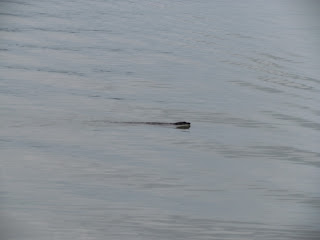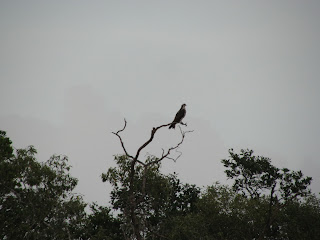The second day of the trip to see the Sundarban Tiger Reserve was all about the reserve itself. Early in the morning, at 6:30, we got up and headed down to the boat. We headed out almost immediately to get to the reserve office. It was directly across the river. Rajesh has built a relationship with the village that is right across from the reserve. There are lots of tourists who come to the reserve to have a look, but most stay in a tourist spot down the river a little bit. Ajay told us that it is crazy and noisy. The people who stay there drink and stay up late and make lots of noise. It sounds thoroughly unpleasant to me. And it seemed that once again, I had found a company that does things the road less travelled way.
We got to the reserve office and handed in our passports for verification and/or registration. I have not yet been to a country that has as many checks on my actual eligibility to be here as India. I don't know what problem with foreigners there is, but it must be quite difficult.
We were also assigned a guide for the day. He was a local man who had trained especially to take tourists into the reserve. Before we set off on our hunt for the royal Bengal tiger, we visited the museum at the reserve office. We passed a pond where there was a crocodile or two. At first we couldn't see it, but before long someone spotted it and we all went out and ooohhed and aaahhed a little bit before trooping inside the museum and having a look around It was a fairly interesting museum, as these sorts of things go, and the best part was that it was fairly small as well, so it didn't outlive its welcome. I learned about the flora and fauna of the park. There was a lot there, and hopefully we were going to be to see a reasonable amount of it. There was also a map of the park. It's quite a sizeable park and there are three zones that make it up. The first is a living area that is around the park. This is where the people live. There are villages and people make there lives there. The second area is a buffer zone. The park office is located at the northern edge of this zone. It extends about one third of the way towards the southern end of the reserve, and this is the area where tourists are allowed to go. They are only allowed into the area with an approved local guide and they must travel by boat with only few spots along the way where it is allowed to debark from the boats. They are the spots where there are wildlife spotting towers/blinds. These areas are fenced to protect tourists from any marauding tigers or other dangerous animals. Also around the very borders of the zone are fences that are designed to deter tigers from crossing the water to the villages and causing trouble.
The third zone is the protected zone. Nobody except for researchers is allowed into this area. The animals are free to live and roam and do their thing without interference from us humans.
We were going to spend the day in the buffer zone, plying the waterways and having a look into the wildlife areas through fences at the towers/blinds. And hopefully spotting a tiger or a crocodile along the way.
 Along with the information about the flora and the fauna of the park, the museum had a small presentation about a local goddess. Her name is Banabibi. She protects people from harm in the park. Before honey collectors or fishermen go into the park, they pray to Banabibi for protection from the tiger god who marauds through the park. The whole story of Banabibi and her brother is a bit complicated, but they were the children of a man and his second wife (because the first wife couldn't have children). The tiger god, who could become a man, was ruling the world until Banabibi defeated him and only gave him dominion over a small part of the world. As a result, people pray to her because she is the only one who can control the tiger god.
Along with the information about the flora and the fauna of the park, the museum had a small presentation about a local goddess. Her name is Banabibi. She protects people from harm in the park. Before honey collectors or fishermen go into the park, they pray to Banabibi for protection from the tiger god who marauds through the park. The whole story of Banabibi and her brother is a bit complicated, but they were the children of a man and his second wife (because the first wife couldn't have children). The tiger god, who could become a man, was ruling the world until Banabibi defeated him and only gave him dominion over a small part of the world. As a result, people pray to her because she is the only one who can control the tiger god.After the museum, we set out on our hunt. For most of the day we plied the canals and waterways of the tourist zone of the reserve. We looked high and low. We took shifts looking at both shores from the boat. We sat at the blinds looking for anything that might be a tiger. Or a crocodile. Or anything more interesting than birds, of which there were many. We did see lots of spotted deer.
We saw an eagle.
We saw a water monitor lizard on the land...
 ...and swimming across the river. This is supposedly quite special as the monitors are almost as rare to see as tigers.
...and swimming across the river. This is supposedly quite special as the monitors are almost as rare to see as tigers.We also saw lots and lots of tourists. Noisy tourists. Obnoxiously noisy tourists. Tourists so obnoxiously noisy that there was very little chance of seeing much of anything in the areas where they were. At the last blind, we had managed to settle down quietly. We were waiting to see if anything would cross to the nearby waterhole. Suddenly another boatload of the noisy tourists landed and plodded loudly down the path to the blind. I don't know why these people can't understand that animals don't really like noise. They don't like being seen by anyone or anything. And when great boatloads of gaggling, shouting, whistling goofballs come roaring into the area, there is very little chance they will stick around, much less show themselves. So having settled ourselves down for a bit of a wait, it became moot. And the others gave up soon after, even though the guide had told us we would be able to stay there for up to an hour and half later, when the area closed, they weren't willing to sit still for that long. So even though they grumbled about not seeing much, they were unwilling to do what was necessary to increase their chances of seeing a tiger. I was a bit disappointed by that, but I was one against 5, so I lost.
We headed back to the boat and the reserve office area, disappointed and empty-handed in terms of tiger sightings. But it was still a good day because the reserve itself is beautiful and we had spent the whole day watching it go by. There really isn't much that can beat a day spent like that. And I was really happy to know that tigers have a place that is protected, where they can live in peace and solitude, even if it means that they don't have to show themselves to curious tourists.
We left our guide and headed back to the village, where things took a bit of a turn for the worse. Om was supposed to be taking care of us, but after we arrived at the guest house, he more or less disappeared. He didn't give us any direction about when dinner would be ready or what we could do with our time for the evening. We did take a walk in the village and met some of the locals. There was a game of soccer going on. Then when it was time for dinner, we had to ask for dinner. Om is a nice young man, but he does have some things to learn about looking after a group of visitors on a trip such as this before he will make a good guide. But in the end, despite feeling a bit neglected by Om, we got our dinner and finished out a fairly successful day of checking out natural animal habitats.






No comments:
Post a Comment